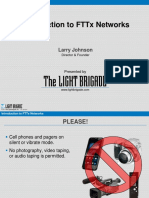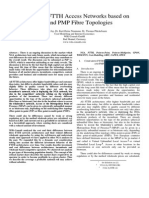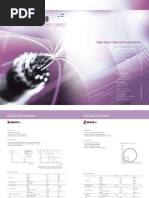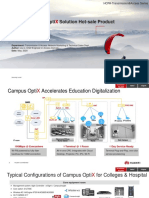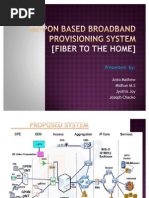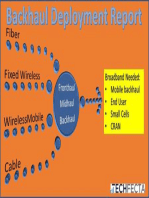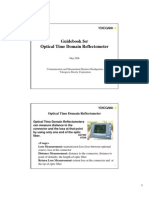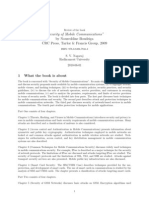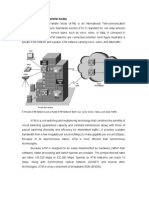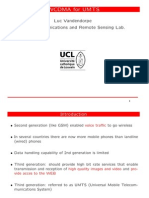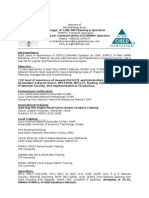100%(1)100% found this document useful (1 vote)
91 viewsFTTH Optical Infrastructure
FTTH Optical Infrastructure
Uploaded by
vijay_786The document discusses standardization activities related to fiber-to-the-home (FTTH) optical infrastructure being conducted by Study Group 15 of the International Telecommunication Union Telecommunication Standardization Sector (ITU-T SG15). It provides an overview of ITU-T SG15's work to develop recommendations for FTTH network construction, including fiber characteristics and testing, optical components, cables, and installation techniques. It also describes some recent activities like agreeing on a new recommendation for bend-insensitive fibers and studying reliability issues for using such fibers in FTTH deployments.
Copyright:
© All Rights Reserved
Available Formats
Download as PDF, TXT or read online from Scribd
FTTH Optical Infrastructure
FTTH Optical Infrastructure
Uploaded by
vijay_786100%(1)100% found this document useful (1 vote)
91 views30 pagesThe document discusses standardization activities related to fiber-to-the-home (FTTH) optical infrastructure being conducted by Study Group 15 of the International Telecommunication Union Telecommunication Standardization Sector (ITU-T SG15). It provides an overview of ITU-T SG15's work to develop recommendations for FTTH network construction, including fiber characteristics and testing, optical components, cables, and installation techniques. It also describes some recent activities like agreeing on a new recommendation for bend-insensitive fibers and studying reliability issues for using such fibers in FTTH deployments.
Original Description:
cv
Copyright
© © All Rights Reserved
Available Formats
PDF, TXT or read online from Scribd
Share this document
Did you find this document useful?
Is this content inappropriate?
The document discusses standardization activities related to fiber-to-the-home (FTTH) optical infrastructure being conducted by Study Group 15 of the International Telecommunication Union Telecommunication Standardization Sector (ITU-T SG15). It provides an overview of ITU-T SG15's work to develop recommendations for FTTH network construction, including fiber characteristics and testing, optical components, cables, and installation techniques. It also describes some recent activities like agreeing on a new recommendation for bend-insensitive fibers and studying reliability issues for using such fibers in FTTH deployments.
Copyright:
© All Rights Reserved
Available Formats
Download as PDF, TXT or read online from Scribd
Download as pdf or txt
100%(1)100% found this document useful (1 vote)
91 views30 pagesFTTH Optical Infrastructure
FTTH Optical Infrastructure
Uploaded by
vijay_786The document discusses standardization activities related to fiber-to-the-home (FTTH) optical infrastructure being conducted by Study Group 15 of the International Telecommunication Union Telecommunication Standardization Sector (ITU-T SG15). It provides an overview of ITU-T SG15's work to develop recommendations for FTTH network construction, including fiber characteristics and testing, optical components, cables, and installation techniques. It also describes some recent activities like agreeing on a new recommendation for bend-insensitive fibers and studying reliability issues for using such fibers in FTTH deployments.
Copyright:
© All Rights Reserved
Available Formats
Download as PDF, TXT or read online from Scribd
Download as pdf or txt
You are on page 1of 30
Lisbon, 25 February 2010
FTTH Optical Infrastructure:
Standardization Activities in SG15
F. Montalti, P. Regio
FTTH Conference 2010
ITU-T Standardization: from G-PON to 10G XG-PON
Lisbon, 25 February 2010
2
Introduction
The development of a modern optical fibre access network is
considered an essential facility with high social impact, beneficial for
the Country in terms of economic growth and availability of new
services for the citizens.
The saturation of copper cables capabilities for ADSL systems, the
lack of bandwidth for launching innovative services, along with the
increase of Capex and Opex to face up network obsolescence, make
attractive the deployment of FTTH technologies.
The new FTTH network will allow the implementation of an all IP
network, provide ultra broadband connectivity for mobile access,
support the convergence of Telecommunications- Media- ICT.
The success of this challenging project relies on the possibility for all
the Players to build up an infrastructure with the state of the art, most
reliable, cost effective and homogeneous technologies. For this
purpose STANDARDS are needed.
In this evolving scenario ITU-T has oriented its studies to produce a
set of Recommendations capable to pave the way toward the
construction of the FTTH networks.
Lisbon, 25 February 2010
3
The road to FTTH
?
Installation techniques
Network development
and maintenance
Fibres and cables and components
Lisbon, 25 February 2010
4
ITU-T SG 15
Standardization activity on FTTH
The standardization of products and installation techniques
relevant for the deployment of FTTX has been addressed since
more than ten years by ITU-T under a global umbrella: products,
planning, deployment and maintenance
This encompasses the development and updating of
standards for the construction of the physical layer of the
access network and the customer premises
The activity related to optical infrastructures and products was
carried out until 2008 by ITU-T in the Study Groups 6 and 15 and
is now under the leadership of Study Group 15 WP2 Optical
access/transport network technologies and physical
infrastructures
Care is taken in the harmonization of standards with other
Standardization Organizations, in particular with IEC TC86 and its
WGs
5
Trends and challenges in the Outside Plant
The construction of the OSP physical layer represents the prevalent
cost in the customer connection. With traditional techniques is in the
range between 60% (in urban areas) and 90% (in rural areas) of the
total plant cost.
The trend of miniaturization of the optical cable structures as well as
the availability of low bend fibres allows the reduction of the ducts
dimensions and, consequently, of the dimensions of the road cutting
The spread of optical fibre cables into the access network is a key
issue with the developement of new infrastructures as well as the re-
using the existing ones both in urban areas and in buildings.
To pave the way to FTTH, Telcos are looking for technologies allowing:
To re-use as far as possible the existing infrastructures (even if
partially occupied by other cables)
To minimize the environmental impact by means of reduced
dimension diggig techniques (or no dig at all!)
To reduce the skill of manpower
ITU-T SG15 is working on the standardization of all the available
technologies to enable FTTH development. Possible solutions include
the development of new installation techniques as well as new
cables and accessories construction.
Lisbon, 25 February 2010
6
Questions assigned to ITU-T SG15 WP2
Lisbon, 25 February 2010
7
Characteristics and test methods
of optical fibres and cables
The responsibility under this Question includes the following
areas for single-mode fibres & multimode fibres
and the following major Recommendations on optical fibers:
G.650 test method series
G.651 multimode 50/125 m
G.652 dispersion unshifted single-mode optical fibre
G.653 dispersion shifted single-mode optical fibre
G.654 cut-off shifted single-mode optical fibre
G.655 non-zero dispersion-shifted single-mode optical fibre
G.656 non-zero dispersion-shifted single-mode fibre for
wideband optical transport
G.657 bending loss insensitive single-mode optical fibre
description / parameters definitions of attributes
test methods for geometrical,
transmission, mechanical and
reliability characteristics
different possible fibre
solutions for local access
networks
Lisbon, 25 February 2010
8
Recent activities on Fibres
Agreement on new Recommendation on
bending-insensitive fibres G.657 optimized for
FTTH deployements
New studies on aspects related to the specific
FTTH installative context in cooperation with
Q.16: reliability, compatibility, etc.
ITU-T Handbook Optical Fibres, Cables and
Systems for Telecommunications
Revision of the main Recommendations on
optical fibres
Lisbon, 25 February 2010
9
ITU-T G. 657 Recommendation on
bend insensitive single-mode fibres
During the last SG15 meeting in Geneva (Oct 2009), agreement has been
reached for the following classification:
G.657 A (G.652 compliant) A1 fibre for 10 mm bending radius
A2 fibre for 7.5 mm bending radius
G.657 B (not G.652 compliant*) B2 fibre for 7.5 mm bending radius
B3 fibre for 5 mm bending radius
Following issues are addressed as the future study point:
- possibility of A3 fibre
- connectivity to G.652 fibre (level of compliance*)
- wavelength dependence of the transmission characteristics
Lisbon, 25 February 2010
10
G.657 fibre technologies
Radius
Refractive index
Radius
Refractive index
Radius
Refractive index
Radius
Refractive index
Matched cladding
single-mode fibre
(standard)
Depressed
cladding single-mode
fibre
Trench assisted
Ring assisted
single-mode fibre
B
e
t
t
e
r
b
e
n
d
l
o
s
s
p
e
r
f
o
r
m
a
n
c
e
Radius
Refractive index
Hole assisted
Specified loss in dB for 1 turn at 1550
nm for radius:
ITU-T 15 mm 10 mm 7.5 mm 5 mm
G. 657A1 <0.025* <0.75 - -
G. 657A2 / B2 <0.03 <0.1 <0.5 -
G. 657B3 - <0.03 <0.08 <0.15
* These values are recalculated from loss data for 10 turns
G.652
G.657 A1
G.657 A2 / B2
G.657 B3
Lisbon, 25 February 2010
11
G.657 fibre reliability issues
using bend insensitive G.657 fibres in FTTH installations..
allows lower attenuations with bending, giving
- the possibility to reduce accessories size (e.g. storage boxes)
allowing installation in crowded infrastructures
- higher power budget margins also in the in house tortuous
paths
- the possibility to use quick and cheap installative methods
!
but some aspects should be carefully analized
- the impact on the fibre lifetime in real installation conditions
of: high numbers of small radius bends, length of fibres involved
and bending + tension stress applied together
- the effect of the compatibility levels between fibres from
different manufacturers (different technologies) on the insertion
loss of splice/connector
- the difficulty to detect severe or wrong installation
conditions with instruments during installation
Lisbon, 25 February 2010
12
Characteristics of optical components and
subsystems
and the following Recommendations are relevant for FTTH:
G.671 transmission characteristics of optical components and
subsystems (PON Splitters, Connectors, Attenuators)
L.12 optical fibre splices
L.13 sealed closures for outdoor environment
L.31 optical fibre attenuators
L.36 single-mode fibre optic connectors
L.37 optical branching components (non-wavelength selective)
L.45, L.46 environment aspects related to the outside plant
L.50, L.51 optical distribution frames for central office
environments
The responsibility under this Question includes active, passive and
hybrid or dynamic/adaptive optical components, devices and
related network infrastructure equipment
Lisbon, 25 February 2010
13
Whats going on
Customer and distribution
boxes and terminals (L.distr)
Pre-terminated fibre drop
cables & hardened connectors
(L.drop)
Environmental protection of
optical devices and optical
connectivity in outside plant
conditions (L.modc)
Outdoor optical cross connect
cabinets (L.oxcon)
Example: Need of new
Recommendations on field mountable
connector technologies
Optimization of
space
Unbundling?
Lisbon, 25 February 2010
14
Optical physical infrastructure and cables
Recommendations on cable construction
L.10 Optical fibre cables for duct and tunnel application (12/2002)
L.26 Optical fibre cables for aerial application (12/2002)
L.43 Optical fibre cables for buried application (12/2002)
L.58 Optical fibre cables: Special needs for access network (03/2004)
L.59 Optical fibre cables for indoor applications (01/2008)
L.60 Construction of optical/metallic hybrid cables (09/2004)
L.67 Small count optical fibre cables for indoor applications (10/2006)
L.78 Optical fibre cable construction for sewer duct applications
(05/2008)
L.79 Optical fibre cable elements for microduct blowing installation
application (07/2008)
Lisbon, 25 February 2010
15
Optical physical infrastructure and cables
Recommendations on installation techniques
L.35 Installation of optical fibre cables in the access network
(10/1998)
L.38 Use of trenchless techniques for the construction of
underground infrastructures for telecommunication cable installation
(09/1999)
L.39 Investigation of the soil before using trenchless techniques
(05/2000)
L.48 Mini-trench installation technique (03/2003)
L.49 Micro-trench installation technique (03/2003)
L.57 Air-assisted installation of optical fibre cables (05/2003)
L.61 Optical fibre cable installation by floating technique (09/2004)
L.73 Methods for inspecting and repairing underground plastic ducts
(04/2008)
L.77 Installation of cables in sewer ducts (05/2008)
Lisbon, 25 February 2010
16
Installation of o. f. units or mini-cables by
blowing technique (L.57) 1/2
96 o.f..
Diameter 15 mm
Weight 200 Kg/Km
Bending Radius 210 mm
Winch installatiion
Up to 120 (144) o.f.
Diameter 8 mm
Weight 50 Kg/Km
Bending Radius 160 mm
Air blowing installation
Traditional cable Mini cable
The reduction of diameter and weight of the mini cables allow
the installation in very small ducts with innovative techniques as
air blowing.
The same products can be installed in overhead plants or on
building facades.
Lisbon, 25 February 2010
17
Installation of o. f. units or mini-cables
by blowing technique (L.57) 2/2
In the same way also the dimensions of ducts can be reduced.
In this new scenario large dimension road cuttings are
unnecessary, as sections of several cm or some tens cm are
sufficient.
Outer Diameter 40
or 50 mm
Diameter 10/14 mm
(inner/outer)
TRADITIONAL
MINIATURIZED
Lisbon, 25 February 2010
18
Low impact minitrench installation
techniques (L.limt)
Installation of mini ducts structures inside a small
dimension trench: width less than5 cm and depth in the
range 20-30 cm (compared with 10x30 cm of the
conventional one)
Possibility of installing up to 3 linear arrays of 5 mini ducts
10/14 mm directly buried
Advantages Drawbacks
Cost effectiveness Difficulty to obtain the permissions by Municipalities
Low impact on
environment and traffic
Medium /low protection grade of the plant
Lisbon, 25 February 2010
19
LightNo-Dig Technique
It is a guided drilling technique with small machines (also for use in
manholes) for the laying of a 40 mm single duct, equipped
with 4 miniducts and with anti rodent protection
It represents an evolution of the technique described in L.38
Advantages Drawbacks
Ease to obtain permissions Need of a georadar survey
Zero impact on environment and traffic Dependance on the soil type
No need of expensive road restoration
Lisbon, 25 February 2010
20
Solutions for installation of ducts and
cables in an occupied infrastructure (L.coi)
Outfitting of existing ducts (telcos, street lighting,power..) with10/12
mm mini ducts
Use of completely dielectric minicables
Separation of the telecomunication access points with the use of
reduced dimensions manholes
Advantages Drawbacks
Cost effectiveness Coexistence with other services
Immediate availability of
Infrastructure
Reduced protection of the plant
No need of expensive road
restoration
Definition of the rules with the
infrastructure owner
Low impact on environment and
traffic
Definition of safety procedure for the O&M
activities
Lisbon, 25 February 2010
21
New technologies in action
Lisbon, 25 February 2010
22
Existing building infrastructures challenges
The most critical issues of the FTTH deployment are related to
the cabling of existing buildings, especially in metropolitan
areas, due to:
Limited availability of TLC infrastructures
Trouble in obtaining permissions for installing at
sight solutions
Old rules related to copper that do not allow to exploit
the dielectric characteristics of optical fibres to make its
installation more flexible
ITU-T SG15 is working on the standardization of all the
new products
accessories
test methods
and installation techniques
optimized for the existing buildings scenario
Lisbon, 25 February 2010
23
About installation in buildings.
Lisbon, 25 February 2010
24
Whats going on
Optical fibre cable functions for premises indoor application (L.caind)
Optical fibre cable constructions for drop application (L.cda)
Optical cabling systems in buildings (L.teib)
Optical fibre cable constructions for new application (L.cna)
Installation of cables in gas ducts (L.cigd)
Installation of cables in water ducts (L.ciwd)
Solutions for installation of ducts and cables in an occupied
infrastructure (L.coi)
Installation of optical fibre units or mini-cables by blowing technique
(L.fubt)
Installation of optical fibre cable by replacement of existing copper
cables (L.recc)
Lisbon, 25 February 2010
25
Maintenance and operation of optical fibre
cable networks
Recommendations on O&M issues
L.25 Optical fibre cable network maintenance (10/1996)
L.40 Optical fibre outside plant maintenance support, monitoring and
testing system (10/2000)
L.41 Maintenance wavelength on fibres carrying signals (05/2000)
L.53 Optical fibre maintenance criteria for access networks (05/2003)
L.64 ID tag requirements for infrastructure and network elements
management (02/2007)
L.66 Optical fibre cable maintenance criteria for in-service fibre testing
in access networks (05/2007)
What are the functional requirements for optical fibre identification?
What procedures and methods can be employed for optical fibre
identification without interrupting optical services?
What kinds of reliable technologies can apply to preserve and
protect outside plant facilities?
Lisbon, 25 February 2010
26
Whats going on
Use of GPS (Global Positioning System) to create
referenced network maps (L.gpsm)
Optical fibre identification for the maintenance of optical
access networks (L.ofid)
Questionnaire on optical fibre identification technologies
Lisbon, 25 February 2010
27
Development of optical networks in the
access area
Recommendations on network design
L.42 Extending optical fibres solutions into the access network
(05/2003)
L.52 Deployment of passive Optical Networks (PON) (05/2003)
L.65 Optical fibre distribution of access networks (12/2006)
L.72 Data bases for optical access network infrastructures (01/2008)
What are the suitable passive optical network (PON)
configurations from initial to final stage?
What are the suitable optical access network for urban areas
and rural areas?
What are the key considerations for indoor and outdoor and
aerial infrastructures?
Lisbon, 25 February 2010
28
Whats going on
Aerial infrastructure design for optical access network
(L.aid)
Passive optical networks (PON) configuration for FTTx
(L.pon)
Technical aspects of unbundling and sharing of outside
plant elements in optical networks (L.shropt)
Optical access network design for urban and rural areas
(L.uara)
Questionnaire on "Optical cabling shared with multiple
operators in buildings"
Lisbon, 25 February 2010
29
Conclusions
In the last ten years of activity, ITU-T SG15 (and SG6)
produced about 40 Recommendations related to FTTH physical
layer;
About 20 Recommendations are in preparation in this study
period addressing fibres reliability items, cost effective
installation techniques, cables and materials for the indoor
brown-field scenario;
The set of Recommendations produced will speed up the FTTH
deployment, as they give timely answers to the most topical
issues and allow the FTTH Players (Operators, Investors) to
make the correct choices for the implementation of a future-
proof optical fibre access network.
Lisbon, 25 February 2010
30
The Authors wish to acknowledge Mr. G. Bonaventura and Mr. R. Casale for the useful comments
You might also like
- Light BrigadeDocument74 pagesLight Brigadepiter100% (1)
- Comparing FTTH Access Networks Based On P2P and PMP Fibre TopologiesDocument9 pagesComparing FTTH Access Networks Based On P2P and PMP Fibre TopologiesWewe SlmNo ratings yet
- Huawei CurbPON Solution OverviewDocument16 pagesHuawei CurbPON Solution OverviewAlexander Pischulin100% (2)
- FCGA Definition of Terms - Revisions2017 PDFDocument9 pagesFCGA Definition of Terms - Revisions2017 PDFDiego ZABALANo ratings yet
- RJ45 Ethernet Wiring DiagramsDocument3 pagesRJ45 Ethernet Wiring DiagramsphilaskNo ratings yet
- Final Project: (System Administration and Maintenance)Document8 pagesFinal Project: (System Administration and Maintenance)Arthuro Del RosarioNo ratings yet
- LTE Network Issue Analysis Guideline V1Document29 pagesLTE Network Issue Analysis Guideline V1Amir Miftahudin100% (1)
- Reference Guide FTTH PONDocument116 pagesReference Guide FTTH PONameeq77100% (3)
- Testing Passive Optical Networks: FTTX Pon GuideDocument84 pagesTesting Passive Optical Networks: FTTX Pon GuideAnonymous 5Pzs8gpVQNo ratings yet
- Reference Guide FTTHDocument116 pagesReference Guide FTTHturbozmej100% (1)
- Making Telecoms Work: From Technical Innovation to Commercial SuccessFrom EverandMaking Telecoms Work: From Technical Innovation to Commercial SuccessNo ratings yet
- LTE Self-Organising Networks (SON): Network Management Automation for Operational EfficiencyFrom EverandLTE Self-Organising Networks (SON): Network Management Automation for Operational EfficiencySeppo HämäläinenNo ratings yet
- FTTX 2012: Markets & Trends Facts & FiguresDocument28 pagesFTTX 2012: Markets & Trends Facts & FiguresyakootahNo ratings yet
- FTTX Solution Ordering Guide: Chapter One: Fiber in The Building SolutionsDocument52 pagesFTTX Solution Ordering Guide: Chapter One: Fiber in The Building SolutionsSergio SanchezNo ratings yet
- FTTH Fiber To The Home Reference ArchitectureDocument10 pagesFTTH Fiber To The Home Reference Architecturewilfried100% (1)
- FTTH Personal ResearchDocument19 pagesFTTH Personal ResearchYves Mathurin Nzietchueng100% (1)
- FTTH Network Installation Guide and Mobile Requirements: January 2013Document56 pagesFTTH Network Installation Guide and Mobile Requirements: January 2013khaledhajjNo ratings yet
- Fujikura - Optical ComponentsDocument42 pagesFujikura - Optical ComponentsSeung-Min LeeNo ratings yet
- FTTHDocument33 pagesFTTHMohola Tebello GriffithNo ratings yet
- GPON - FundamentalsDocument18 pagesGPON - FundamentalsMuhammad Sharif Janjua0% (1)
- Gpon at GlanceDocument115 pagesGpon at Glancefay86No ratings yet
- Maxis Fiber InstallationDocument15 pagesMaxis Fiber InstallationMuhamad Ashraff100% (1)
- IMaster NCE Optical Resource Assurance APP V100R19C00 User Guide 01Document341 pagesIMaster NCE Optical Resource Assurance APP V100R19C00 User Guide 01VVLNo ratings yet
- Bktel FTTH SolutionsDocument9 pagesBktel FTTH SolutionsVivin ViolitaNo ratings yet
- Inventory of FTTH in Europe: Press Release, 11 February 2009Document4 pagesInventory of FTTH in Europe: Press Release, 11 February 2009nitsuiNo ratings yet
- Passive Optical Network (PON) : Eco-Friendly Network InfrastructureDocument53 pagesPassive Optical Network (PON) : Eco-Friendly Network InfrastructureYuwanTaraNo ratings yet
- EXFO Reference-Poster FTTx-PON-Testing en PDFDocument3 pagesEXFO Reference-Poster FTTx-PON-Testing en PDFAnonymous 5Pzs8gpVQNo ratings yet
- Destination FTTHDocument80 pagesDestination FTTHmorozco1965No ratings yet
- CRR 718 Ben FTTHDocument66 pagesCRR 718 Ben FTTHanupkrajakNo ratings yet
- Fast ConnectDocument9 pagesFast ConnectGustavo100% (1)
- R. K. Gangwar DE (Transmission) BRBRAITT, JabalpurDocument57 pagesR. K. Gangwar DE (Transmission) BRBRAITT, JabalpurRanjit SinghNo ratings yet
- FTTH Lab: Syed Mohammad Arsalan ShahDocument30 pagesFTTH Lab: Syed Mohammad Arsalan ShahSayed ZohaibNo ratings yet
- Televes OLT512 Optical Line TerminalDocument1 pageTeleves OLT512 Optical Line TerminalBastian AtenasNo ratings yet
- Fiberhome FTTH ISP SolutionDocument16 pagesFiberhome FTTH ISP SolutionAbdullatif100% (1)
- Passive Network Design 1Document30 pagesPassive Network Design 1jorgefuriasse100% (1)
- HOW GPON WorkDocument13 pagesHOW GPON WorkHarsh Zaveri100% (1)
- FTTH Handbook 2021-200-326Document127 pagesFTTH Handbook 2021-200-326Adrián Tonatiu González FloresNo ratings yet
- FTTX - PON - EXFO - Guide Installation PDFDocument116 pagesFTTX - PON - EXFO - Guide Installation PDFneoloader145No ratings yet
- GPON: The Standard For PON Deployment and Service Evolution: OSI Confidential InformationDocument23 pagesGPON: The Standard For PON Deployment and Service Evolution: OSI Confidential Informationchaidar_lakareNo ratings yet
- PON DesignDocument57 pagesPON Design0509035100% (2)
- Fiber Access Solution FTTx-PONDocument39 pagesFiber Access Solution FTTx-PONMohamed Shabana100% (1)
- FTTH Solutions BrochureDocument3 pagesFTTH Solutions BrochureAli VaelizadehNo ratings yet
- Accessories: Europe/Middle East/Africa Product Selection GuideDocument68 pagesAccessories: Europe/Middle East/Africa Product Selection GuideShiela Monique FajardoNo ratings yet
- Section 6 B2H SOPDocument91 pagesSection 6 B2H SOPDayaram SahNo ratings yet
- FTTH Network Efficiency From Uneven 2.0 To QuickODN 3.0Document20 pagesFTTH Network Efficiency From Uneven 2.0 To QuickODN 3.0Carlos PariseNo ratings yet
- FTTH Design For ResidentialDocument8 pagesFTTH Design For Residentialkausar108No ratings yet
- Poster GPONDocument1 pagePoster GPONsinggih HPMNo ratings yet
- FTTH Solution Overview HuaweiDocument24 pagesFTTH Solution Overview HuaweiRodil ortiz urbano100% (1)
- 09 Huawei Campus OptiX Solution Hot-Sale Product - EN v1.0Document28 pages09 Huawei Campus OptiX Solution Hot-Sale Product - EN v1.0Luis RodriguezNo ratings yet
- TransmissionDocument32 pagesTransmissionahmad7160No ratings yet
- 02 Etisalat FTTX SeminarDocument24 pages02 Etisalat FTTX SeminarLuc Vu TienNo ratings yet
- Alcatel-Lucent GPON Brochure PDFDocument8 pagesAlcatel-Lucent GPON Brochure PDFSteven HungNo ratings yet
- FTTH DesignguideDocument51 pagesFTTH DesignguideAmir Rashid100% (3)
- Telecomunications Cabling Specification v5Document77 pagesTelecomunications Cabling Specification v5Tamer Elmaghraby100% (1)
- FTTH Designing Network LinkDocument26 pagesFTTH Designing Network LinkAnto MathewNo ratings yet
- Test FTTHDocument23 pagesTest FTTHSanjeev KoulNo ratings yet
- Optical and Microwave Technologies for Telecommunication NetworksFrom EverandOptical and Microwave Technologies for Telecommunication NetworksNo ratings yet
- Esdm IrdtDocument259 pagesEsdm Irdtvijay_786No ratings yet
- ICSE Board Class X Biology Board Paper 2008 (One Hour and A Half)Document9 pagesICSE Board Class X Biology Board Paper 2008 (One Hour and A Half)vijay_786No ratings yet
- Installing Backtrack 5 R1 in Virtual MachineDocument44 pagesInstalling Backtrack 5 R1 in Virtual Machinevijay_786No ratings yet
- OTU-8000 Optical Test Unit: Rack-Mounted Fiber Test For Backbone, Metro, and Access NetworksDocument2 pagesOTU-8000 Optical Test Unit: Rack-Mounted Fiber Test For Backbone, Metro, and Access Networksvijay_786No ratings yet
- Guidebook For Optical Time Domain ReflectometerDocument12 pagesGuidebook For Optical Time Domain ReflectometerkumarsachinguptaNo ratings yet
- Safety PosterDocument1 pageSafety Postervijay_786No ratings yet
- Tax Saving Options Fy2012-2013Document5 pagesTax Saving Options Fy2012-2013vijay_786No ratings yet
- OFC Applications GuidelinesDocument27 pagesOFC Applications Guidelinesvijay_786No ratings yet
- DSL: An Overview: by M. V. Ramana MurthyDocument9 pagesDSL: An Overview: by M. V. Ramana Murthyvijay_786No ratings yet
- FTTH Drop and Indoor CablesDocument8 pagesFTTH Drop and Indoor Cablesvijay_786No ratings yet
- ZXSDR BS8800Document9 pagesZXSDR BS8800vijay_786No ratings yet
- 18-MSTP Configuration - 206300 - 1285 - 0Document59 pages18-MSTP Configuration - 206300 - 1285 - 0vijay_786No ratings yet
- 1xev: 1X Evolution Is-856 Tia/Eia Standard: Airlink OverviewDocument27 pages1xev: 1X Evolution Is-856 Tia/Eia Standard: Airlink Overviewflatelecom938No ratings yet
- EVDO Rel A Basic-20081212Document23 pagesEVDO Rel A Basic-20081212badri1969revanthNo ratings yet
- Cdma2000 1xRTTDocument19 pagesCdma2000 1xRTTvijay_786No ratings yet
- 2010 TF Boudriga SecurityMobileCommDocument3 pages2010 TF Boudriga SecurityMobileCommvijay_786No ratings yet
- ATM (Asynchronous Transfer Mode)Document7 pagesATM (Asynchronous Transfer Mode)vijay_786No ratings yet
- Wcdma For Umts: Luc Vandendorpe UCL Communications and Remote Sensing LabDocument49 pagesWcdma For Umts: Luc Vandendorpe UCL Communications and Remote Sensing LabAngelica NaguitNo ratings yet
- E53.17.x, E53.15.x, and E50.13.x Summary of Firmware ChangesDocument8 pagesE53.17.x, E53.15.x, and E50.13.x Summary of Firmware ChangesDaniel MirandaNo ratings yet
- Red Hat JBoss Enterprise Application Platform-7.0Document81 pagesRed Hat JBoss Enterprise Application Platform-7.0JavedNo ratings yet
- Red Hat Enterprise Linux 7 Security Guide en USDocument223 pagesRed Hat Enterprise Linux 7 Security Guide en USAnca Daniela TeodorescuNo ratings yet
- PHPIPAM 1.2.1 Multiple VulnerabilitiesDocument4 pagesPHPIPAM 1.2.1 Multiple VulnerabilitiesFhahryNo ratings yet
- Maldives Guide2009Document60 pagesMaldives Guide2009Vamsi aravetiNo ratings yet
- Test SAP Solution Manager: Document CategoriesDocument6 pagesTest SAP Solution Manager: Document CategoriesDinesh BabuNo ratings yet
- RTP PresentationDocument25 pagesRTP PresentationMouni RoyNo ratings yet
- BEL Engineers Notice 11 06Document5 pagesBEL Engineers Notice 11 06SAURABH KUMARNo ratings yet
- Leslie F. Stebbins - Building Back Truth in An Age of Misinformation-Rowman & Littlefield Publishers (2023)Document207 pagesLeslie F. Stebbins - Building Back Truth in An Age of Misinformation-Rowman & Littlefield Publishers (2023)Fabrizio José Benito LozanoNo ratings yet
- WWW Kratikal Com Blog 2420-2Document8 pagesWWW Kratikal Com Blog 2420-2Pallavi DuttaNo ratings yet
- VX800 Shop Manaul PlusDocument1,178 pagesVX800 Shop Manaul PlusTerry Hoey67% (3)
- CV KhaleduzzamanDocument4 pagesCV KhaleduzzamanMd KhaleduzzamanNo ratings yet
- CP R80.20.20 1500 1600 1800 Appliance Series AdminGuide Locally ManagedDocument282 pagesCP R80.20.20 1500 1600 1800 Appliance Series AdminGuide Locally ManagedThuong Nguyen HaiNo ratings yet
- U6 Mixed 3 PDFDocument4 pagesU6 Mixed 3 PDFMario David Mondragon LinaresNo ratings yet
- NHD Annotated BibDocument5 pagesNHD Annotated Bibapi-273955864No ratings yet
- Address Resolution Protocol (ARP)Document11 pagesAddress Resolution Protocol (ARP)fortunatesanjibNo ratings yet
- VXLAN - TheoryDocument38 pagesVXLAN - Theorymahihasan190199No ratings yet
- CCNP SWITCH v7.0 Chapter 2Document5 pagesCCNP SWITCH v7.0 Chapter 2GiannisDemetriouNo ratings yet
- Term Paper RituDocument25 pagesTerm Paper RituMuhammad Zehadul IslamNo ratings yet
- Roots AssignmentDocument15 pagesRoots AssignmentZuhaib LuqmanNo ratings yet
- IT - Regular Service - Week 23 - 2024Document7 pagesIT - Regular Service - Week 23 - 2024vamnuggetNo ratings yet
- QUESTIONAIREDocument3 pagesQUESTIONAIREsunny12101986No ratings yet
- Veyon User Manual en 4.2.4Document28 pagesVeyon User Manual en 4.2.4Rocket ProjectNo ratings yet
- Starlight by Olivia WildensteinDocument698 pagesStarlight by Olivia Wildensteingislaine dutra100% (1)
- Willis F. Whitehead - Three Books of Occult Philosophy or Magic (1898)Document316 pagesWillis F. Whitehead - Three Books of Occult Philosophy or Magic (1898)qbl777No ratings yet
- Final of Practical Research 2 Jan 15Document16 pagesFinal of Practical Research 2 Jan 15joville100% (1)
- Mcm301 - Midterm Solved PaperDocument6 pagesMcm301 - Midterm Solved PaperFahad Nabeel67% (6)
